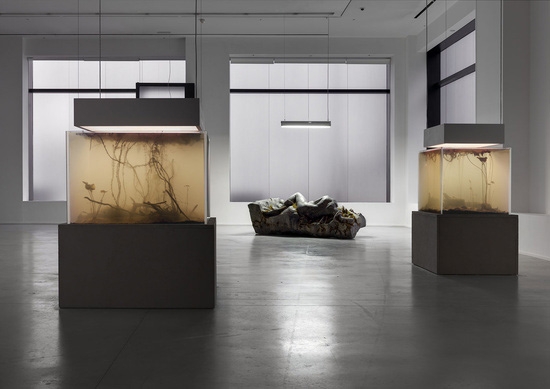Try to remember what the weather was at this time exactly two months ago. This September just gone might have been the driest in the UK ‘since records began’, but I’m pretty sure that doesn’t stop any of the daily weather-nattering, the ‘oh, that’s nothing compared to last year…’ What about a year ago, a hundred years ago, or 30 million? Pierre Huyghe’s three most recent aquarium works in his solo show In. Border. Deep blink and go opaque intermittently; at points you can see fish among the lily roots and the salamanders struggling up to the surface before the glass walls turn milky white.
The contents of each Nymphéas Transplant (all works 2014) are taken from the ponds that Monet built in Giverny during the 1890s, and the stuttering of the switchable glass that contains each is programmed according to records of the weather during the four years between 1914 and 1918 during which Monet painted his Nymphéas series. What Huyghe is giving us is a glimpse beneath the familiar water lilies of the paintings, to the life underneath. And the glass tells us… when it was cloudy? Or maybe just overcast. How do we tell the difference between drizzle, downpour or fog? It is, admittedly, a trivial quibble, but Huyghe’s attempt to reanimate the paintings through visualising meteorological accounts of those wartime days is a limited insight (no pun intended), as we occasionally glimpse the limited and proscribed ecology in each tank. He might, if we’re being generous, be suggesting that the temperatures and notes that archive the weather conditions and Monet’s paintings are equal ‘facts’, that each can be used as tools in accessing, activating and remembering the past. But then it’s just a blinking aquarium.
Prometheus-like attempts to reanimate or create new life fill the darkened gallery: La Déraison is a classical sculpture of a headless reclining woman, a heating element running through the marble and concrete apparently emulating the human circulatory system, and encouraging moss and spiders to nestle in its warm crevices; De-extinction is a video that dwells for 12 minutes on the details and textures of a piece of amber, finally settling on an unlucky pair of insects who were caught mid-intercourse, trapped together in their compromised position for millions of years. The star of this menagerie is undoubtedly in the video Human Mask, where in a post-Fukushima abandoned sake house, a sole, odd figure lurks: a Macau monkey, wearing a porcelain-white mask of a young girl’s face, complete with a flowing wig of black hair. It’s mesmerising and all too human, as the monkey sits comfortably in the darkened space, jogging its leg and playing absentmindedly with strands of hair. It’s a competent, compelling existential mood-piece.
But compared to footage of the mundanely bizarre true story on which it’s based, where the proprietor of an establishment in Utsunomiya, Japan, dresses his two pet monkeys in gaudy, chubby-cheeked masks with crude makeup and lets them deliver hot towels to giggling customers, Huyghe’s video is a smooth, but needless, one-liner. The title of the work doesn’t help, being at once literal, but also sounding like the title of a trite, throwaway sci-fi story, perhaps with the tagline, ‘We’re all just monkeys trapped in an abandoned sake house’. Huyghe’s work has always been haunted by origins, tracing the filaments of authorship and control, often unspooling them until they release a shimmering echo of associations. Here, his wayward Prometheus keeps Huyghe’s creations on a short leash, where they remember their pasts too clearly and are still too closely tied to their sources, left feeling flat and inert.
This article was first published in the December 2014 issue.
